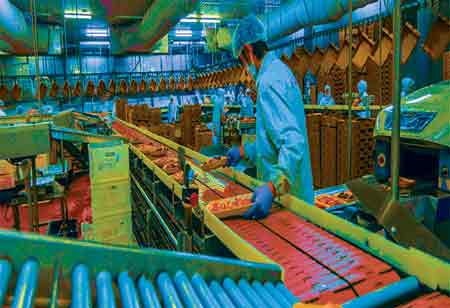THANK YOU FOR SUBSCRIBING
Be first to read the latest tech news, Industry Leader's Insights, and CIO interviews of medium and large enterprises exclusively from Food and Beverage Tech Review
How Drones, Robots, and Hyperlocal Delivery are Changing the Food Delivery Industry
The food delivery landscape in Europe is undergoing significant transformation due to evolving consumer preferences and advancements in technology.

By
Food and Beverages Tech Review | Saturday, January 06, 2024
Stay ahead of the industry with exclusive feature stories on the top companies, expert insights and the latest news delivered straight to your inbox. Subscribe today.
The European food delivery industry is transforming with drones, robots, and hyperlocal models, projected to reach €74.3 billion by 2025, requiring collaborations with traditional restaurants.
FREMONT, CA: The food delivery landscape in Europe is undergoing significant transformation due to evolving consumer preferences and advancements in technology. The traditional reliance on a friendly neighbour delivering the best pizza is a thing of the past. Presently, there is a shift towards faster, more efficient, and environmentally conscious methods of delivering favourite meals, with drones, robots, and hyperlocal delivery models emerging as pivotal players in this evolution.
Drone Delivery Takes Flight
It is increasingly plausible to envision a scenario where one can conveniently order a morning croissant and have it promptly delivered via an aerial drone. This technology is particularly beneficial in areas with limited road access, as it enables swift meal transportation across challenging urban terrains within a matter of minutes.
Robots Roll into the Kitchen
Robots are working hard to transform the food preparation process while drones take care of the skies. Robots are turning kitchens into extremely efficient centres, from AI-powered burger flippers to automated pizza-making equipment. This guarantees consistent quality and hygiene while also expediting the food preparation process.
Hyperlocal Delivery: Freshness on Demand
In the domain of food delivery, paramount importance is placed on the fusion of freshness and convenience. This growing demand finds its fulfilment through hyperlocal delivery services, acting as intermediaries between customers and nearby eateries or cafés. These services, exemplified by industry leaders like Deliveroo and Uber Eats, ensure swift delivery of food within a specified radius, thereby guaranteeing its temperature and freshness straight from the kitchen.
Sustainability Takes Center Stage
In response to the escalating environmental consciousness, stakeholders within the food delivery sector are increasingly embracing sustainable practices. This shift involves the substitution of gas-powered vehicles with electric scooters and bicycle fleets, effectively reducing carbon emissions. Furthermore, businesses are proactively exploring alternatives such as compostable materials and recycled packaging, aligning with the broader commitment to eco-friendly practices and minimizing environmental impact.
The Future is Foodie
Undoubtedly, the trajectory of food delivery in Europe is poised for significant advancement. The forthcoming evolution in food ordering and consumption methods heralds a transformative era, featuring drones navigating the skies, automated culinary expertise, and local champions delivering freshly prepared meals within moments. Consequently, the prospect of encountering an unwavering robotic chef or a sophisticated aerial companion delivering the desired meal may not be far-fetched during the next craving. Within this realm, Europe stands at the forefront, pioneering an enthralling expedition towards the future landscape of food delivery.
The European food delivery sector is projected to attain a market value of €74.3 billion by 2025, showcasing substantial growth prospects. Notably, hyperlocal delivery stands out as the most rapidly expanding segment within this market landscape. An evident surge in investments directed towards drone delivery startups across Europe underscores the increasing focus and confidence in innovative logistical solutions. Emphasising sustainability has emerged as a pivotal factor distinguishing service providers, exemplified by platforms introducing carbon-neutral delivery choices. Furthermore, fostering collaborative partnerships between food delivery entities and traditional restaurants remains imperative for achieving broader market acceptance and ensuring sustained success in this evolving industry landscape.
I agree We use cookies on this website to enhance your user experience. By clicking any link on this page you are giving your consent for us to set cookies. More info







